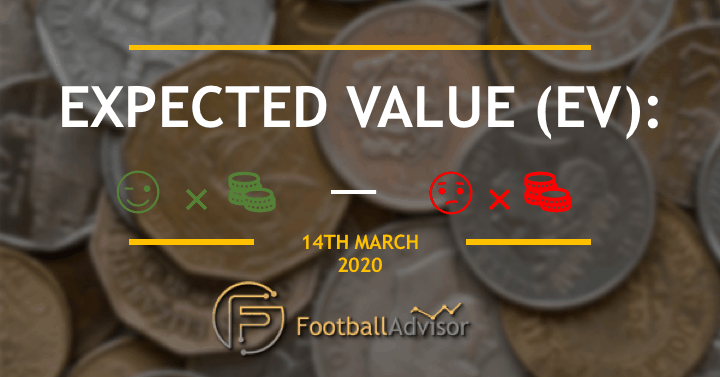Using Expected Value (EV) To Increase Your Profits

Is Expected Value (EV) the REAL Way to Make a Long-Term Profit from Sports Betting?
Punters are often so focused on ‘winning’ that they are unable to see if their strategy is a successful one. Instead of an obsession with the percentage of victorious wagers, it is far more essential to look at whether your selections offer ‘value'. In theory, you could win 80% of your bets, however, if the average odds were just 1.15, you are going to lose in the long-term.
When you continually find ‘value’ in your bets, it means you will eventually beat the bookmaker. It does, however, require immense patience and dedication, especially when losing streaks hit. Expected Value (EV) is a method of determining what you can expect to win or lose from a wager in the long run. It is a vital tool in the quest for profitability.
Knowing my EV at all times is vital to my betting. It makes the mental side so much easier when you know your average expected returns, winnings, profits and overall value. It's like my comfort blanket when experincing the inevitable downswings that come along – Jon
What is Expected Value?
Often abbreviated to EV, Expected Value is a measure of whether a wager is likely good or bad value. If you have a ‘positive’ expected value, the bet is probably going to be profitable if performed over a long period. ‘Negative’ EV suggests you will lose money.
Every single punter must understand whether they are getting ‘value’ for their cash. A basic understanding of probability goes a long way. Let’s say you fancy Watford to beat Liverpool at odds of 5.00. At this price, the implied probability of a Watford win is 20%. It is a ‘value’ bet if the true chance of the Hornets winning is higher, say 25%+. EV merely provides a calculation on how profitable or not your bets are likely to be.
How to Calculate Expected Value
The actual formula is straightforward:
(The amount won per wager x the probability of winning) – (The amount lost per wager x probability of losing)
A theoretical 50/50 bet, such as a coin toss, is an easy way to explain EV. You know that as long as the coin is not compromised, there is a 50% chance of it landing on heads, and 50% on tails. Therefore, the ‘fair’ odds of choosing either outcome is 2.00. Any bet at odds above 2.00 is ‘value.’ Anything below 2.00 is not.
You often see bookmakers offering a price of 1.83 for an ‘odd’ or ‘even’ number of goals, for example. Such odds represent truly terrible value. You can use EV to discover just how bad it really is when you wager £10 on this market:
(8.30 x 0.5) = 4.15 (10 x 0.5) = 5
4.15 – 5 = -0.85
You have a negative EV of 0.85 in this instance. It means you will lose £0.85 for every £10, a bookie edge of 8.5%.
You can also use EV when calculating Profit on Turnover (POT). While you can work out the EV of each bet, it is time-consuming when looking at a significant level of data. Those who can establish an overall profit margin can estimate the EV of their turnover. It is a potentially useful strategy but requires detailed record keeping and a LOT of information.
For instance, you may know that your POT is 5% because you have earned £5,000 from your last £100,000 worth of wagers. If you also know the bookmaker’s edge, you can estimate the amount you could expect to lose across your total stakes.
Why is Expected Value Important?
I hope it is self-explanatory! If your average wager means you give up an edge of 8.5%, you are going to lose in the long-term. For every £10,000 you bet, you will lose £850. Winning streaks don’t mean as much, as losing streaks are likely longer than you expect. The ‘risk of ruin’ to your bankroll increases significantly.
In contrast, if you consistently score a positive EV with your wagering, mathematically speaking, you will come out on top. Yes, losing streaks and downturns are inevitable. However, if you combine a positive EV with a suitable staking method and a high enough bankroll, you can absorb the losses and come back even stronger.
How to use Expected Value in Your Betting
Calculating EV is straightforward in games where you already know the probability of winning and losing. For example, the house edge for the roulette wheel is approximately 2.7%, depending on the type of wheel you use and wagers you make. It is significantly harder to calculate and use EV in sports betting.
We can utilise the most sophisticated software on the market. However, the truth is, we don’t know the real probability of any sports event until after it is completed. If you think differently and believe you know when you have an ‘edge,’ you can apply a staking method such as Kelly’s Criterion to drive home your advantage. Remember, however, your bankroll will take a significant hit if your calculations are incorrect.
As the odds provided by a bookmaker are subjective, you won’t necessarily lose money with a negative EV by your estimation. Imagine you believe your negative EV is 0.4. This figure suggests you are giving up an edge of 4%. However, if the bookie is wrong by say 7%, you actually have a positive EV without realising!
It is worth considering the process of calculating your own odds via a model such as Poisson Distribution. You can determine a price and compare it with the odds on offer.
How On Earth Would I Know The Bookmakers Edge?
It's a fair point and this where in my experience that a lot of punters fall down. It starts talking about things which, in some circumstances, can be very hard (or even impossible) to know, such as a bookmakers edge. They think it is too hard and simply give up – understandably so…
This is why I always recommend focusing on the things that you DO know or CAN CONTROL
This means bet record-keeping. I have 1,000s of records from all of my betting models and members of our services will know that we have several years of results for all our services.
With this we can use the market odds as our barometer for the bookmakers edge, while also using our turnover as a guide to our profitability (E.g. Profit on Turnover Edge).
In a simple example, your bet record shows an average odds of 2.00 but you are winning 60% of the time. There is your edge. Over a big enough sample, you can combine that with your POT to determine your real opportunity.
The Crowd Isn’t Always Wise, or Fast
It is also important to remember that the market decides that odds. If you use an exchange like Betfair, it means your fellow punters have made back or lay bets, and their actions determine the price. These odds ‘should’ ultimately represent the actual probability of an event occurring.
In horse racing or football markets, in particular, getting involved early in a market is potentially very beneficial. After calculating what you feel are the ‘real’ odds, check the bookies, especially the Betfair Exchange, to see what the market says at the beginning. If the odds are way off in your favour, make the wager if you believe you have a positive EV. If the market price gets cut, you know it was the right decision! At this stage, you can ride out the bet or trade for a small profit.
How Can You Profit From Expected Value In The Real World?
Our very own FA Racing Lays service ticks all the boxes that would you need from a betting service – plus it solves the Biggest Problem With Lay Betting.
Lay betting is a useful tool in your betting armoury – but only if handled correctly.
It's great because it usually means you get a much higher strike rate (and that winning feeling). After all, you usually have more outcomes running in your favour.
Generally it is easier to find the horse that WON'T win in any given race, than the one that WILL win the race.
But the biggest problem with this approach? The liability…
You can get winner after winner but then a losing lay comes along and wipes out your profit.
Well not anymore…
The FA Racing Lays model Has Revolutionised The Lay Betting Approach
– with some quite spectacular results.
By focusing solely on exposed and over bet favourites, with a maximum lay odds of just 2.50 (6/4), we have created a hugely attractive lay betting approach.
Here is a quick overview
- Lay Win and Lay Place
- Maximum Lay Odds of 2.50 (6.40)
- Maximum exposure of just 1.5 points per lay – solving the biggest issue with lay betting… the liability
- Drawdown of just 18 points over three years
- Small betting bank friendly – just 60 point betting bank advised
- 224 points profit since the beginning of 2017
FA Racing Lays and Expected Value
Let's start with the base numbers
- 2,719 Bets over 3 years
- 1,253 successful (win) lays
- 46.08% strike rate (successful lays)
- 1.80 Average Lay Odds
- £161,828 staked (liability)
- £11,166.22 profit
Edge Based On Turnover (POT)
So the first thing that we can determine here is our Profit On Turnover – or, our Expected Edge based on Turnover.
£161,828 / £11,166.22 = 6.90% (EDGE)
That's a great start and a clear edge, particularly so for Lay Betting.
With a low Drawdown over more than three years, of just 18 points. Meaning you could follow a service like this with 40-60 point bank.
£10 Stake = £400-£600 bank
£50 Stake = £2,000 – £3,000 bank
£100 Stale = £4,000 – £6,000 bank
And as we are betting against strong favourites, with high liquidity, the stakes could be scaled even further.
So we have been able to determine the following
- Clear, Positive Edge
- Low Volatility / Drawdown
- Consistent and High Strike Rates
- Scalable – Large Stakes Possible
- Suitable to use a compound stakes model
By now, I am sure you are beginning to see why FA Racing Lays is one of our most popular models…
>>> Click here to learn more about FA Racing Lays

Jon is the Founder and Chief Tipster at Football Advisor and Predictoloy. He started life as data analyst in the digital marketing field before find his true calling in the world of Football and Horse Racing Betting.
Jon has been sharing his professional expertise since 2009 and specialises in using objective data analysis and subjective experience of betting built up over more than a decade of professional betting.
In 2014, Jon also launched (and continues to run) the trusted Football Advisor service service which provides a variety of football and horse racing betting models and portfolios. A few years later, Jon launched the Predictology platform which is the worlds first betting system builder and analyser covering a wealth of football betting related statistics covering more than 200,000 matches.
Jon has also lent his knowledge and expertise to several of the trusted Premium Services offered by the respected Secret Betting Club, including Football Lay Profits. Racing Bet Profits and, most recently, Racing Lay Profits.
